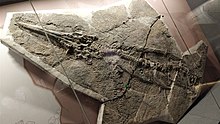| Guizhouichthyosaurus Temporal range: Triassic,
| |
|---|---|

| |
| Skeleton of Guizhouichthyosaurus tangae in Geological Museum of Guizhou | |
| Scientific classification | |
| Domain: | Eukaryota |
| Kingdom: | Animalia |
| Phylum: | Chordata |
| Class: | Reptilia |
| Order: | †Ichthyosauria |
| Genus: | †Guizhouichthyosaurus |
| Species: | †G. tangae
|
| Binomial name | |
| †Guizhouichthyosaurus tangae Cao & Luo, 2000 (type)
| |
| Synonyms | |
| |
Guizhouichthyosaurus is an extinct genus of ichthyosaur which is known primarily from the Xiaowa Formation of the lower Carnian stage of the Late Triassic in southwest China. The type species of this genus is Guizhouichthyosaurus tangae, of which multiple skeletons are known. It has been reassigned as a species of the genus Shastasaurus in the past, though it has since been considered distinct. The ichthyosaurs Cymbospondylus asiaticus, named in 2002, and Panjiangsaurus epicharis, named in 2003, are junior synonyms of G. tangae. The genus is also known from the Ladinian-aged Middle Triassic Zhuganpo Formation; additionally, the species "Callawayia" wollongangense may belong to Guizhouichthyosaurus.
Guizhouichthyosaurus is a large ichthyosaur, typically measuring approximately 5 metres (16 ft) long with some specimens exceeding 6 metres (20 ft). The snout is long and powerful, and there is a low sagittal crest on the rear part of its skull. The tail is bent downwards near its end, the scapulae (shoulder blades) are shaped like sickles, and an opening is enclosed between each set of lower leg bones. Each limb contains a minimum of four digits. Two distinct morphotypes of Guizhouichthyosaurus are known, differentiated by skull and limb morphology, which likely represent males and females.
Guizhouichthyosaurus, like other early ichthyosaurs, would have used anguilliform (eel-like) locomotion, unlike the more efficient cod- and tuna-like swimming of later ichthyosaurs. While one specimen of Guizhouichthyosaurus contained gastroliths as stomach contents, their ingestion may have been accidental, as stomach stones are very uncommon in ichthyosaurs. Despite its small, smooth-edged teeth, Guizhouichthyosaurus is known to have been able to consume other large marine reptiles, as evidenced from a thalattosaur skeleton in the stomach region of one specimen, indicating that Guizhouichthyosaurus was an apex predator.